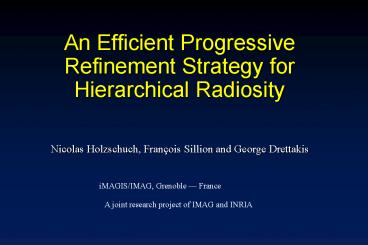An Efficient Progressive Refinement Strategy for Hierarchical Radiosity - PowerPoint PPT Presentation
Title:
An Efficient Progressive Refinement Strategy for Hierarchical Radiosity
Description:
Hierarchical radiosity is a significant step in radiosity algorithms ... Perform an a posteriori test to determine whether refinement was required: MAGIS. i ... – PowerPoint PPT presentation
Number of Views:26
Avg rating:3.0/5.0
Title: An Efficient Progressive Refinement Strategy for Hierarchical Radiosity
1
An Efficient Progressive Refinement Strategy for
Hierarchical Radiosity
- Nicolas Holzschuch, François Sillion and George
Drettakis
iMAGIS/IMAG, Grenoble France
A joint research project of IMAG and INRIA
2
Motivation
- Hierarchical radiosity is a significant step in
radiosity algorithms - creates links between patches and refines them
- linear in the number of elements created
- Proceeds top-down
- First establish links between input surfaces
- Then refine these links where needed
3
Motivation (2)
- Initial linking step quadratic in the number of
polygons - Many top-level links will never carry significant
energy - Subdivision is often too high
4
Proposed improvements
- Delaying initial linking of input surfaces
- Reducing the number of links
5
Our test scenes
6
Initial Linking
- Proportion of top-level links with BF lt ?
7
Subdivision
8
Previous work
- Hierarchical radiosity (Hanrahan, 90- 91)
- Link refinement based on radiance and form-factor
- proceed from top to bottom
- multigridding
- Importance-driven hierarchical radiosity (Smits,
Arvo Salesin, 92) - Links refined using importance and influence on
the final image
9
Previous work (2)
- Hierarchical radiosity and discontinuity meshing
(Lischinski, Tampieri Greenberg 93) - First refine patches using a discontinuity mesh,
then re-refine using radiosity and form-factor - Structured sampling (Drettakis Fiume 93)
- Adapt mesh to illumination structure
10
Delaying initial linking
- Delay top-level linking between input surfaces
until strictly necessary - First iteration results achieved more rapidly
- Spread computation over several iterations
- Avoid part of initial linking computation gain
on total computation time
11
Classification of pairs
- Initially, all pairs of polygons are un-classified
Un-classified
- Important pairs progressively become
classified.
- We compute visibility tests only for
classified pairs.
Classified
Un-classified
Visible
Partial
Invisible
12
Linking algorithm
- First record all polygon pairs as un-classified.
- As soon as a pair qualifies for linking (BF gt
?), compute visibility and link it accordingly. - The remainder of the algorithm is not modified.
13
Energy Balance
- Partially linked polygons do not emit all their
energy - Un-radiated energy affects the energy balance
- quantify the importance of this lost energy
- compare it with the overall precision of the
algorithm. - Unit sum of form-factors allows estimation of
lost energy
14
Energy Balance
15
Reducing the number of links
- Perform an a posteriori test to determine whether
refinement was required
16
Reducing the number of links
- We cancel the refinement if the following four
expressions are true
17
Results first iteration
18
Results ten iterations
19
Subdivision
20
Conclusion
- Delaying top-level linking between input surfaces
- storage costs are reduced
- we obtain first results earlier
- still quadratic in the number of input surfaces
- Reducing the number of links
- improved subdivision criterion
- limits un-necessary subdivisions
- Future work
- Simplify already subdivided meshes






























